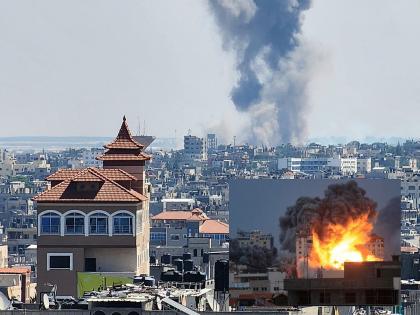Exact reason behind Israel-Hamas war conflict
By Lokmat English Desk | Updated: October 9, 2023 20:54 IST2023-10-09T20:53:20+5:302023-10-09T20:54:13+5:30
In a major escalation on October 7, Hamas launched a "surprise attack" on Israel, firing a barrage of rockets ...

Exact reason behind Israel-Hamas war conflict
In a major escalation on October 7, Hamas launched a "surprise attack" on Israel, firing a barrage of rockets into the southern and central parts of the country. Israel has declared a "state of war" following Hamas's attack.
Hamas and Islamic Jihad launched a remarkably intense and unprecedented offensive, while Israel experienced a significant intelligence failure. The ramifications of these events are profound and enduring. Prime Minister Benjamin Netanyahu stated that Israel was in a state of war and that Palestinians would face substantial consequences.
Armed insurgents infiltrated Jewish communities along the Gaza border, resulting in casualties and the abduction of both civilians and soldiers. Unconfirmed videos depicted frightened Israelis, bloodied and bound, being escorted by Palestinian gunmen. Amidst this chaos, numerous individuals sought refuge in secure rooms within their residences as the violence unfolded. By nightfall on Saturday, the Israel Defence Forces (IDF) estimated there were still 200-300 Palestinian militants inside Israel. There were eight “points of engagement” where the IDF was trying to regain control from militants.
The precise motivations behind Hamas and Islamic Jihad's attack are not definitively known. However, the escalation in violence can be attributed to ongoing tensions that had been building up for months between Israeli soldiers and settlers and Palestinians in the West Bank. This period saw instances of armed settlers targeting Palestinian villages, militants in the West Bank launching attacks against soldiers and settlers, and repeated Israeli Defense Forces (IDF) operations in Palestinian cities. These cumulative factors likely contributed to the eruption of hostilities. Jews have been praying inside the Al-Aqsa mosque's grounds in Jerusalem's Old City for the past week. Muslims refer to the region surrounding the mosque as Haram al-Sharif, and it is the third holiest site in Saudi Arabia after Mecca and Medina. It is revered as the location of the biblical Jewish temple and is referred to as the Temple Mount by Jews. Jews are not allowed to pray inside the Al-Aqsa compound because doing so would be extremely offensive. Hamas has called its current offensive Operation al-Aqsa Deluge.
The tiny strip, which is home to 2.3 million people, was the target of a wave of bombings by Israel, which mobilised reserve soldiers. Netanyahu warned Palestinians in Gaza to get out of there now as he vowed to reduce Hamas hideouts to rubble, but there is nowhere for those in the blockaded territory to escape to. Warplanes targeted several buildings in the centre of Gaza City, including Palestine Tower, an 11-storey building that houses Hamas radio stations. Israel has cut off Gaza's access to electricity and fuel, which might soon have an impact on the medical facilities there, which are already under a lot of strain from those who have been hurt in the bombardment. The estimated death toll in Hamas attack in Israel and subsequent battles has jumped to 800. According to Israel Health Ministry, 2506 people injured have been taken to hospitals, including 23 who are in critical condition and 353 who are seriously wounded.
Hamas must have planned this offensive for many months, and it is a mystery why Israeli intelligence appears to have had no idea it was coming. Israel’s surveillance of Gaza is intense. It monitors activity, communications and daily life via state-of-the-art surveillance equipment, including drones flying over the strip. It also relies on human intelligence via informants, many of whom are blackmailed or otherwise coerced into assisting Israel.
The militant organization that has governed the Gaza Strip since 2007 has demonstrated its significant influence, but it's challenging to envision a favorable outcome for either Hamas or Gaza arising from the recent events. Israel is likely to employ its military capabilities extensively to suppress militant activities, extending beyond Gaza into the West Bank and East Jerusalem. Regrettably, this approach is expected to result in a significant number of civilian casualties among Palestinians, along with substantial damage to homes and infrastructure.
Many people in Gaza just want to get on with their lives, free from the blockade and repeated wars and conflicts. They resent the restrictions imposed on them and the fear instilled in them by Hamas rulers.
Open in app